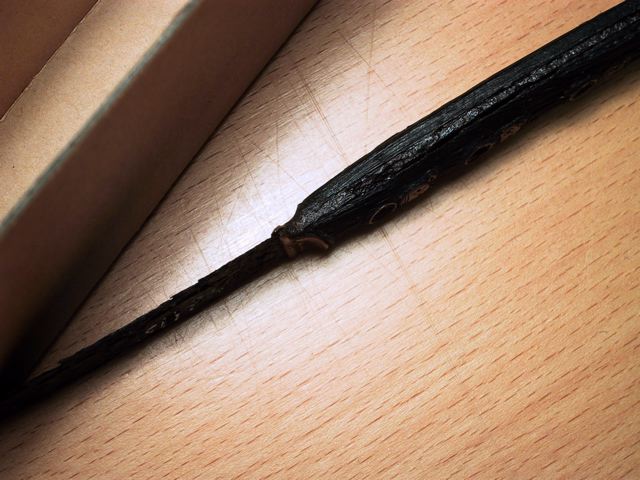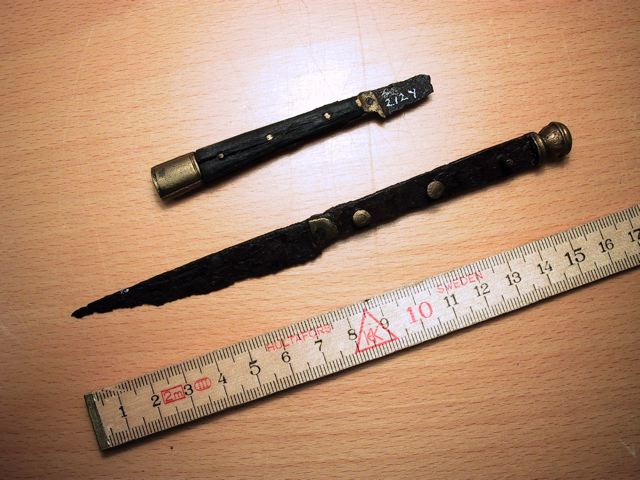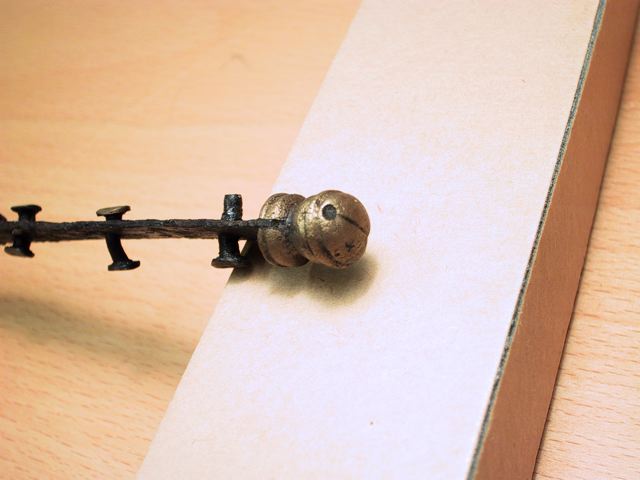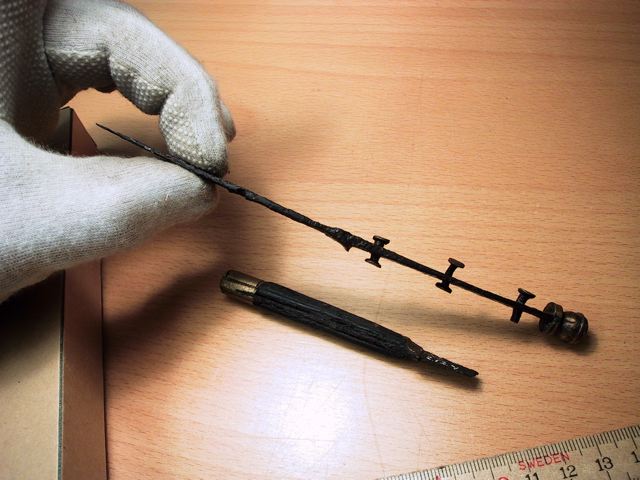| Author |
Message |
|
Peter Johnsson
Industry Professional
|
 Posted: Wed 23 Apr, 2008 11:39 pm Post subject: Posted: Wed 23 Apr, 2008 11:39 pm Post subject: |
 |
|
When I make these knives I fasten the plate with a rivet going through both scale and plate.
I pre bend the plate to right angles.
Both grip scale and plate are wider then the tang at the time of mounting, but the end that is to be covered with the folded plate is naturally shaped and I have filed the inside of the scale to accept the thickness of the plate along the tang.
I use epoxy as extra precaution when mounting, but it might be possible to do this without glue at all. It might also be possible to use hide glue
I have opted to use epoxy with my knives so far.
I normally use short lengths of brass tube as rivets, for tubular rivets. At the time of mounting they are simply pushed through the holes in tang and scale (and bolster plates) and left proud.
The one "trick" I use to make sure the plats does not spring back as I shape them after the glue has set, is to do a thorough annealing before mounting. If the plates are made soft after having being bent to right angles, they can take the last bit of forming without wanting to spring back. I use a small drift and a small hammer when shaping the bolster plates back over the grip scales.
If you have a thicker plate 1-1.5 mm you can also do some limited file decoration after the plate has been shaped back over the grip scale. On many originals the bolster plate was very thin. Some has shallow groves cut in or ridges saved out of the material.
I shape the contour of the grip scales after the glue is set and after I have shaped the bolster plates. The filing can also help making the bolster plate conform to the grip scales if you make sure to file from the right direction.
The last thing I do before finishing the surface, is to widen the ends of the tubular rivets with two pointed drifts. I pace one in a vice, point upwards, rest the knife grip with one of the rivets riding over the point and insert another drift in the facing hole. By *lightly* tapping with a small hammer the ends of the tube will expand forming a small trumpet. Turn the knife over a few times during the process to get an even result. It does not take a lot of force or a large expansion for the tubular rivets to get a grip. In fact, one should be careful not to split the grip scales.
Below I attach some photos of knives found in the Fyris river, that flows through Uppsala.
They date from the first quarter of the 16th C.
The rivets on these are obviously not tubular, but solid.
Also worth noting is that the rivet securing the bolster plates can be riveted separately. In this case with a small iron rivet.
 Attachment: 60.12 KB Attachment: 60.12 KB

 Attachment: 65.25 KB Attachment: 65.25 KB

 Attachment: 35.69 KB Attachment: 35.69 KB

 Attachment: 56.7 KB Attachment: 56.7 KB

|
|
   |
 |
|
Aaron Schnatterly
|
 Posted: Thu 24 Apr, 2008 5:58 am Post subject: Posted: Thu 24 Apr, 2008 5:58 am Post subject: |
 |
|
Peter, it sounds as though we have been using a pretty similar method.
Thanks for the pics, too... look like nice little knives!
| Peter Johnsson wrote: | | The one "trick" I use to make sure the plats does not spring back as I shape them after the glue has set, is to do a thorough annealing before mounting. If the plates are made soft after having being bent to right angles, they can take the last bit of forming without wanting to spring back. |
This helps a lot. It also helps to make sure the material is dead (annealed) ahead of working, too... learned when I tried to use some shim stock that got mixed into my soft metals pile. Started bending... and... *snap!*...
| Peter Johnsson wrote: | | I use a small drift and a small hammer when shaping the bolster plates back over the grip scales. |
Steel mandrel here... like a chisel-edged creasing stake. I usually aim for a couple of degrees extra bend, so it has a bit of a pinching fit on the scale.
There are some that I have on my "to do" list (not a queue, per se, since they aren't spoken for... yet, and no priority to them) that will have some chased or filed bolsters plus a few more little neat elements.
| Peter Johnsson wrote: | I normally use short lengths of brass tube as rivets, for tubular rivets. At the time of mounting they are simply pushed through the holes in tang and scale (and bolster plates) and left proud.
The last thing I do before finishing the surface, is to widen the ends of the tubular rivets with two pointed drifts. |
Been wanting to try this method, but haven't yet picked up any tubular pin material. Thanks for the tips on the method of assembly! Now, I really want to give this a go!
Perhaps soon, I'll post in-progress pics of the cutlery work on one, if there's interest.
|
|
   |
 |
Sean Flynt

|
 Posted: Thu 24 Apr, 2008 6:39 am Post subject: Posted: Thu 24 Apr, 2008 6:39 am Post subject: |
 |
|
| D. Austin wrote: |
I'm looking forward to seeing your St. Bartholomew knife. How far along are you on the project?
|
It's next on the list after I finish my all-consuming sallet project this month. So, given my 30 minutes per week work window  maybe I'll finish knife and scabbard by mid-summer. I'll have more reshaping to do on the tang now that I'm going to use the shoulder plates rather than pinned bolsters, but that's easy work. Thanks to Aaron's post here I'd say I now have all the information I need to proceed. maybe I'll finish knife and scabbard by mid-summer. I'll have more reshaping to do on the tang now that I'm going to use the shoulder plates rather than pinned bolsters, but that's easy work. Thanks to Aaron's post here I'd say I now have all the information I need to proceed.
I'm still planning to roll my own tubular rivets from flat stock but I won't shed blood or tears if it looks like it'll be more trouble than it's worth. Annealed brass is pretty easy to work with, though, so I'm optimistic.
Thanks for the great tips, folks!
-Sean
Author of the Little Hammer novel
https://www.amazon.com/Little-Hammer-Sean-Flynt/dp/B08XN7HZ82/ref=sr_1_1?dchild=1&keywords=little+hammer+book&qid=1627482034&sr=8-1
|
|
   |
 |
|
|
You cannot post new topics in this forum
You cannot reply to topics in this forum
You cannot edit your posts in this forum
You cannot delete your posts in this forum
You cannot vote in polls in this forum
You cannot attach files in this forum
You can download files in this forum
|
All contents © Copyright 2003-2024 myArmoury.com — All rights reserved
Discussion forums powered by phpBB © The phpBB Group
Switch to the Basic Low-bandwidth Version of the forum
|

